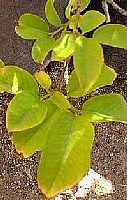View crop
View crop Data sheet EcoPortMyrciaria cauliflora
 |
|
| Notes |
|---|
| BRIEF DESCRIPTION A small, slow growing handsome evergreen or deciduous tree reaching a height of up to 10-12 m. It has one or more trunks and the branches emerge close to the ground and spread to give a dense, wide, round and symmetrical crown. The leaves are ovate or lanceolate, 5 x 25 cm, smooth and shiny. The fruit is a berry 2-3 cm in diameter, initially red and shiny black when ripe. USES The fruit is juicy, has a sweet flavor and is eaten fresh, used for jellies or to prepare liqeurs and wines. KILLING T Young trees will not tolerate frost, while mature trees may survive -2 to -4°C for few hours. GROWING PERIOD Perennial. First bearing after 6-10 years. COMMON NAMES Jaboticaba, Brazilian grape tree, Jaboticatuba sabara, Jaboticaba murta, Jaboti-catuba, Jaboticaba grande, Jaboticaba olho-de-boi, Jaboticaba-de-cabinho, Iba-puru, Yabuticaba. FURTHER INF Scientific synonyms: M. edulis, M. plicato-costata, Eugenia cauliflora, E. edulis, Plinia cauliflora, Myrcizia jaboticaba. Jaboticaba is native of Brazil. It occur within the latitudinal range 21°S-30°S at elevations above 500 m. | Sources |
| SOURCES (M. cauliflora (Mart.) Berg) Argles G 1976 pp 513-517 [FER, DEP, KTMP, USE] Roecklein J 1987 pp 220 [USE, RAIN, TEMP, KTMP] Duke J 1975 pp 22 [TEMP, RAIN, PH] Duke J 1979 pp 105 [TEMP, RAIN, PH] Bermejo J 1994 pp 229-230 [USE, DEP, PH, FER] Fouque A 1972 Bonassieux M 1988 Atta M 1990 pp 65 |